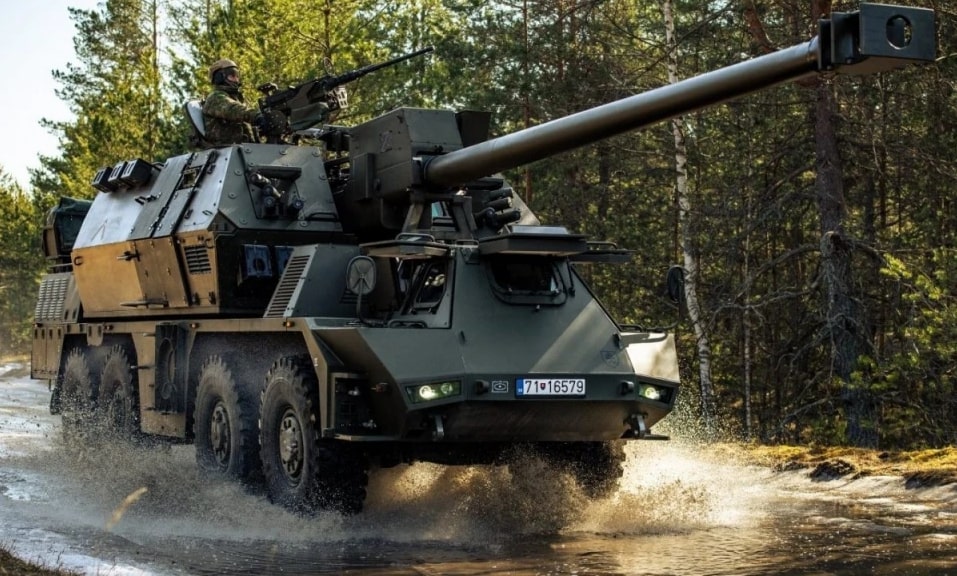In Slovakia, the stance of the newly elected government under Fico has shifted noticeably. Before the elections, the government firmly stated, "we will never provide Ukraine with any weapons." However, following the elections, this position has softened to a more nuanced "we will not supply the weapons that are in storage."
In fact, the new weapons produced in Slovakia, for example, Zuzana howitzers and ammunition, can and will be in Ukraine because of existing contracts. This also applies to the agreements on joint production, if Slovakia wants to remain a reliable partner in the world defense market.
Another anti-Ukrainian government of Orban’s Hungary also rapidly ramps up defense production in cooperation with German Rheinmetall and other regional partners.
Even though those weapons won’t go to Ukraine in the short term, some will eventually replenish the European stockpiles that are already in deficit. This will also help maintain Ukraine's military aid at a high level during 2024, providing crucial capabilities in addition to those already contracted by the Ukrainian government at the expense of nearly all tax money available in the budget.
Matej Kandrik, Chief Executive Director of the Slovakian Adapt Institute, and Attila Demko, head of the Hungarian Center for Geopolitics, shared their perspective regarding Slovakian and Hungarian defense industries while speaking at the Ukrainian Central European Forum 2023 in Lviv, Ukraine.
They called for some caution when assessing anti-Ukrainian statements of politicians, given that the defense industry operates not according to statements but according to business logic. Here are the main takeaways.
Slovakian defense industry booms with record profits while helping Ukraine
New Slovak Minister of Foreign Affairs Juraj Blanár, while visiting Prague in November 2023, announced that previous statements about “no weapons to Ukraine” do not apply to commercial deals. It is not surprising. Slovak defense industry is already booming, with companies reporting record profits, Kandrik said.
“Certainly, it would not be rational for the current government to meddle with this because it will cost jobs and money, including sanctions for the failure to perform contracts. Moreover, it would damage heavily the reputation of Slovakia as a reliable partner. Therefore, rhetorics before elections and after elections can differ greatly.”

State-owned Constructor Defense, which produces famous Zuzana howitzers, increased its year-on-year sales by 33% to EUR 84.6 million in 2022. Its net profit increased by 921% from less than EUR 1.4 million in 2021 to almost EUR 14 million in 2022.
The S holding, which is part of the BMD group, a joint stock company with the state majority, invested EUR 30 million only in 2023 to increase its ammunition production. For 2023, the production plan was set at the level of 50,000 shells per year, and it is projected to grow to 150,000 shells in 2025.
In addition, there is growing production of the famous demining system Bozhena, which is also crucial for Ukraine.
Joint Slovakian-Ukrainian production
There are already several projects between Slovakia and Ukraine in defense production, research, and development.
For example, the Ukrainian Kramatorsk Heavy Machine Building plant established cooperation with the mentioned Constructor Defense on joint development and modernization of the new Ukrainian 155-mm self-propelled howitzer Bohdana.
Meet Bohdana, Ukraine’s gritty goddess of war with NATO-caliber punch
Kandrik believes the Ukrainian defense industry should become self-sufficient to meet the needs of the Armed Forces. At the same time, joint ventures are critical to doing this. Creating joint ventures between Ukrainian and European Defense companies will breach existing gaps and unlock the potential for new production capacities and innovations.
It begins by developing joint maintenance and repair capabilities to cover platforms already deployed in Ukraine. The second step should be focused on procuring weapons from newly created joint production entities in Ukraine.
“For the success of such endeavor, one can't avoid the business logic behind it. It becomes possible only with solid multi-year contracts because only contracts will provide stability and predictability for enterprises to secure investments,” Kandrik says.
Ukrainian input to European defense industry and technologies
Ukraine’s role should be based on its experience, sophisticated engineering, and, most of all, lessons from the battlefield. Ukraine develops its technologies, especially in UAVs, naval drones, and even missiles.
“The Neptune missile is absolutely great product for the regional market because it will be cheaper than American or European missiles,” Kandrik believes. “And now Ukraine has already created a missile with a range of 700 kilometers, although we don't know the name and specification yet.”
Ukraine’s defense industry can develop even further with access to Western technologies. Although technology is always a sensitive issue, the delivered platforms or systems already have crucial and sensitive technology built in. Giving the technological documentation with the specifics is different, but there is trust already to proceed further.
“Obviously, nobody will share the most modern, up-to-date technology. The reason is simple: nobody wants this technology to fall into enemy hands.”
When it comes to the Javelins, for example, the ones Ukraine has received are the older models. The newest models of the Javelins have not been delivered. But even these systems constitute a frogleap compared to the previous technological level.
Hungary's growth of defense industry offers lessons for Ukraine

Ukraine has to buy into the development of weapon systems — then technology will be shared for sure, and Ukrainian companies will be part of the development of that system, says Attila Demko, head of the Hungarian Center for Geopolitics.
He shows Hungarian rapid development of the defense industry as an example. The decision was made in 2017 to build new factories covering all the most crucial types of weapons during the next ten years. As of 2023, most of these factories are already operating. German Rheinmetall played the role of the key partner.
For example, Hungary joined the regional cooperation program to develop and produce the German tank KF 51 at the Zalaegerszeg factory in Hungary. The development contract worth €288 million was signed on 15 December 2023. Rheinmetall is cooperating in the project with the state-owned Hungarian holding company N7, which holds a 49% stake in the joint venture Rheinmetall Hungary.
Five years ago, there was not much beyond the production of some small arms, military trucks, and electronic warfare in Hungary. In 2022, there were three major new factories, including the production of the most modern IFVs, while by 2027, the construction of all ten new factories will be completed.
The assembly of IFVs Lynx has already started in Western Hungary in 2023. Also, by 2027, Hungary will be one of the biggest producers of 155 mm artillery shells
in NATO. The factory for shells is almost ready and will start working in the first months of 2024. It will contribute to the production of shells, which are currently a big problem in Europe. EU promised a million shells for Ukraine in 2023 but delivered only 300,000.
Hungary develops its defense industry in the framework of regional cooperation, mainly with Germany but also with Czechia, Italy, Turkiye, and in some ways with Israel. The goal of Orban’s government was to develop the defense industry fast, not finding out anything already invented. At the same time, Hungary did not want to be an assembly plant where a few workers put together pieces of equipment from other factories. The plan was also to get involved in the development of brand-new systems together with market leaders. For example, next to the Lynx factory in western Hungary, the state built, in cooperation with Rheinmetall, a modern test facility for autonomous land systems. Ukraine is also actively using land drones, which will be one of the new trends.
Other projects include producing parts for Airbus helicopters and producing light weapons based on Czech license since 2019. Hungary has also started drone production and has developed a jet drone with a speed of 500 km per hour. It can mimic a fighter jet to trick enemy radars and air defense.
The Hungarian government also purchased the Hintenberger Defense, which is one of the best manufacturers of mortars worldwide. Mortars proved to be important in the Russo-Ukrainian war, along with 155-mm shells. Finally, Hungary acquired 80% of Aero Vodochody, which is a Czech aerospace company. It will continue production in the Czech Republic but together with Hungary.
Private investors were also involved, such as Beretta company, which produces NATO small arms and ammunition, and Dynamit Nobel, which will produce anti-tank weapons in Hungary.
In total, the ten-year program involves $20 billion in investments.
“It was never said that weapons produced in Hungary can not go to Ukraine. It was only said that Hungarian weapons in the military stock would not go to Ukraine. Now, if it is a weapon made in Hungary in cooperation with Rheinmetall and if it goes to Poland and replenishes Polish 155 mm rounds which go to Ukraine, then it de-facto helps Ukraine,” Atilla said, claiming that even if current Orban’s government is characterized by anti-Ukrainian rhetoric, it doesn’t mean that Hungarian defense production won’t help NATO and at least indirectly Ukraine.
There is European security, not merely Hungarian security. If thousands of additional shells are made, they are already improving the security of Europe, regardless of whether they are used in Ukraine or replenish someone’s stock, he emphasized.
At the same time, this positive impact on NATO is expected after companies fulfill their first contracts with the Hungarian government and start selling abroad.
Read more:
- Russia ramps up production of Shahed drones, Ukraine says
- Ukrainian special services exposed how Western components are shipped to Russia for Lancet drones
- Ukraine starts utilizing iron decoy equipment to deceive Russian strike drones
- British intel: North Korea on course to become Russia’s major arms supplier alongside Iran, Belarus
- Kyiv to create defensive industry alliance, aiming to ensure stable weapons supply
- Ukraine ramps up weapons production with US, Italian support
- Ukraine deploys 2,000 domestically manufactured drones to most critical fronts of war
- Ukrainian govt expedites production of electronic warfare equipment
- Denmark purchases facility to restart domestic ammunition production
- Ukraine to boost defense production sevenfold in 2024 budget plan





